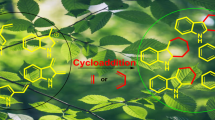Abstract
A dicarboxylate ligand, 5-carboxyl-1-carboxymethyl-2-oxidopyridinium (H2L), was utilized to form four complexes with the general formula [M(HL)2(H2O)]·2H2O, M = CuII (1), ZnII (2), MnII (3), CdII (4). The crystals were isomorphous, belonging to the monoclinic C2/c space group. They were constructed from 1D chains and further linked by hydrogen bonds into a novel binodal (6,8)-connected 3D supramolecular network with twofold self-penetration. Photoluminescence studies revealed that complexes 2–4 displayed intense structure-related fluorescent emission bands.
Similar content being viewed by others
References
Kitaura R, Seki K, Akiyama G, Kitagawa S. Porous coordination-polymer crystals with gated channels specific for supercritical gases. Angew Chem Int Ed, 2003, 42: 428–431
Noro S, Kitaura R, Kondo M, Kitagawa S, Ishii T, Matsuzaka H, Yamashita M. Framework engineering by anions and porous functionalities of Cu(II)/4,4’-bpy coordination polymers. J Am Chem Soc, 2002, 124(11): 2568–2583
Carlucci L, Ciani G, Proserpio DM. Polycatenation, polythreading and polyknotting in coordination network chemistry. Coord Chem Rev, 2003, 246: 247–289
Proserpio DM, Hoffman R, Preuss P. Possible hard materials based on interpenetrating diamond-like networks. J Am Chem Soc, 1994, 116(21): 9634–9637
Ockwig NW, Delgado-Friedrichs O, O’Keeffe M, Yaghi OM. Reticular chemistry: Occurrence and taxonomy of nets, and grammar for the design of frameworks. Acc Chem Res, 2005, 38: 176–182
Wells AF. Three Dimensional Nets and Polyhedra. New York: Wiley, 1977
James SL. Metal-organic frameworks. Chem Soc Rev, 2003, 32: 276–288
Yaghi OM, O’Keeffe M, Ockwig NW, Chae HK, Eddaoudi M, Kim J. Reticular synthesis and the design of new materials. Nature, 2003, 423: 705–714
Liu CM, Gao S, Zhang DQ, Zhu DB. Three-dimensional eight- or four-connected metal-organic frameworks tuned by hydrothermal temperatures. Cryst Growth Des, 2007, 7, 1312–1317
Hill RJ, Long DL, Turvey MS, Blake AJ, Champness NR, Hubberstey P, Wilson C, Schröder M. Unprecedented bilayer topologies in 5- and 6-connected framework polymers. Chem Commun, 2004, 16: 1792–1793
Fang QR, Zhu GS, Jin Z, Xue M, Wei X, Wang DJ, Qiu SL. A multifunctional metal-organic open framework with a bcu topology constructed from undecanuclear clusters. Angew Chem Int Ed, 2006, 45(37): 6126–6130
Cheng JW, Zheng ST, Yang GY. Diversity of crystal structure with different lanthanide ions involving in situ oxidation-hydrolysis reaction. Dalton Trans, 2007, 36: 4059–4066
Long DL, Hill RJ, Blake AJ, Champness NR, Hubberstey P, Proserpio DM, Wilson C, Schröder M. Non-natural eight-connected solid-state materials: A new coordination chemistry. Angew Chem Int Ed, 2004, 43(14): 1851–1854
Jia JH, Lin X, Wilson C, Blake AJ, Champness NR, Hubberstey P, Walker G, Cussena EJ, Schröder M. Twelve-connected porous metal-organic frameworks with high H2 adsorption. Chem Commun, 2007, (8): 840–842
Wang X, Qin C, Wang E, Su Z, Li Y, Xu L. Self-assembly of nanometer-scale [Cu24I10L12]14+ cages and ball-shaped keggin clusters into a (4,12)-connected 3D framework with photoluminescent and electrochemical properties. Angew Chem Int Ed, 2006, 45(44): 7411–7414
Thirumurugan A, Rao CNR. 1, 2-, 1, 3- and 1,4-benzenedicarboxylates of Cd and Zn of different dimensionalities: Process of formation of the three-dimensional structure. J Mater Chem, 2005, 15: 3852–3858
Shi X, Zhu GS, Wang XH, Li GH, Fang QR, Zhao XJ, Wu G, Tian G, Xue M, Wang RW, Qiu SL. Polymeric frameworks constructed from a metal-organic coordination compound, in 1-D and 2-D systems: Synthesis, crystal structures, and fluorescent properties. Cryst Growth Des, 2005, 5(1): 341–346
Ye BH, Ding BB, Weng YQ, Chen XM. Multidimensional networks constructed with isomeric benzenedicarboxylates and 2, 2’-biimida-zole based on mono-, bi-, and trinuclear Units. Cryst Growth Des, 2005}, 5}: 801–
He YH, Feng YL. 5-Carboxy-1-carboxymethyl-2-oxidopyridinium. Acta Cryst, 2007, E63: o3422
Spek AL. PLATON, An integrated tool for the analysis of the results of a single crystal structure determination. Acta Cryst, 1990, A46: C34
Sheldrick GM. SHELXS-97 and SHELXL-97, solfware for crystal structure analysis, siemens analytical X-ray instruments Inc., Madision, Wisconsin, USA, 1997
Du M, Zhang ZH, Tang LF, Wang XG, Zhao XJ, Batten SR. Molecular tectonics of metal-organic frameworks (MOFs): A rational design strategy for unusual mixed-connected network topologies. Chem Eur J, 2007, 13: 2578–2586
Michael W. Two polymorphs of a piperazinium zincophosphate with different interrupted SOD-type frameworks. Micropor Mesopor Mat, 2002, 54: 331–339
Tao J, Tong ML, Shi JX, Chen XM, Seik WN. Blue photoluminescent zinc coordination polymers with supertetranuclear cores. Chem Commun, 2000, 2043–2044
He YH, Feng YL, Lan YZ, Wen YH. Syntheses, structures and photoluminescence of four d10 metal coordination polymers constructed from 3,5-bis-oxyacetate-benzoic acid. Cryst Growth Des, 2008, 8: 3586–3594
Author information
Authors and Affiliations
Corresponding author
Rights and permissions
About this article
Cite this article
Zhan, C., Cai, W., Feng, Y. et al. An unusual binodal (6,8)-connected 3D supramolecular network with twofold self-penetration. Sci. China Chem. 53, 1261–1265 (2010). https://doi.org/10.1007/s11426-010-3178-x
Received:
Accepted:
Published:
Issue Date:
DOI: https://doi.org/10.1007/s11426-010-3178-x




